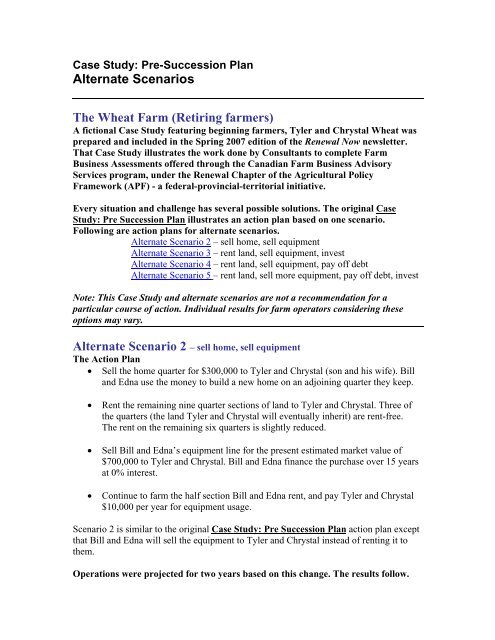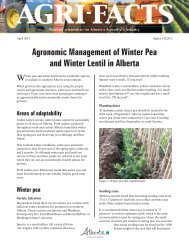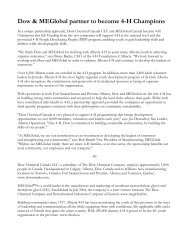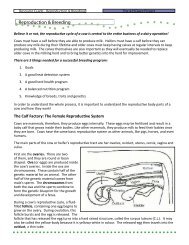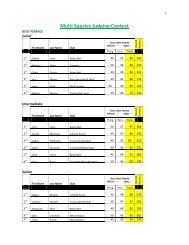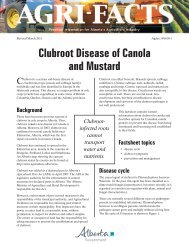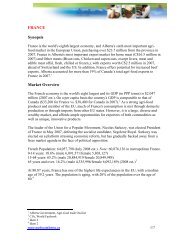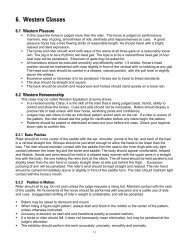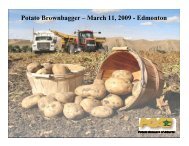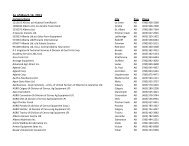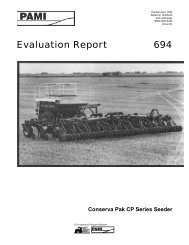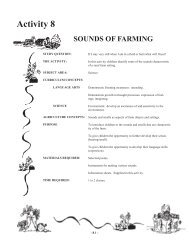Case Study #1, Scenario 2: The Kattel Farm, J - Agriculture and ...
Case Study #1, Scenario 2: The Kattel Farm, J - Agriculture and ...
Case Study #1, Scenario 2: The Kattel Farm, J - Agriculture and ...
You also want an ePaper? Increase the reach of your titles
YUMPU automatically turns print PDFs into web optimized ePapers that Google loves.
<strong>Case</strong> <strong>Study</strong>: Pre-Succession Plan<br />
Alternate <strong>Scenario</strong>s<br />
<strong>The</strong> Wheat <strong>Farm</strong> (Retiring farmers)<br />
A fictional <strong>Case</strong> <strong>Study</strong> featuring beginning farmers, Tyler <strong>and</strong> Chrystal Wheat was<br />
prepared <strong>and</strong> included in the Spring 2007 edition of the Renewal Now newsletter.<br />
That <strong>Case</strong> <strong>Study</strong> illustrates the work done by Consultants to complete <strong>Farm</strong><br />
Business Assessments offered through the Canadian <strong>Farm</strong> Business Advisory<br />
Services program, under the Renewal Chapter of the Agricultural Policy<br />
Framework (APF) - a federal-provincial-territorial initiative.<br />
Every situation <strong>and</strong> challenge has several possible solutions. <strong>The</strong> original <strong>Case</strong><br />
<strong>Study</strong>: Pre Succession Plan illustrates an action plan based on one scenario.<br />
Following are action plans for alternate scenarios.<br />
Alternate <strong>Scenario</strong> 2 – sell home, sell equipment<br />
Alternate <strong>Scenario</strong> 3 – rent l<strong>and</strong>, sell equipment, invest<br />
Alternate <strong>Scenario</strong> 4 – rent l<strong>and</strong>, sell equipment, pay off debt<br />
Alternate <strong>Scenario</strong> 5 – rent l<strong>and</strong>, sell more equipment, pay off debt, invest<br />
Note: This <strong>Case</strong> <strong>Study</strong> <strong>and</strong> alternate scenarios are not a recommendation for a<br />
particular course of action. Individual results for farm operators considering these<br />
options may vary.<br />
Alternate <strong>Scenario</strong> 2 – sell home, sell equipment<br />
<strong>The</strong> Action Plan<br />
• Sell the home quarter for $300,000 to Tyler <strong>and</strong> Chrystal (son <strong>and</strong> his wife). Bill<br />
<strong>and</strong> Edna use the money to build a new home on an adjoining quarter they keep.<br />
• Rent the remaining nine quarter sections of l<strong>and</strong> to Tyler <strong>and</strong> Chrystal. Three of<br />
the quarters (the l<strong>and</strong> Tyler <strong>and</strong> Chrystal will eventually inherit) are rent-free.<br />
<strong>The</strong> rent on the remaining six quarters is slightly reduced.<br />
• Sell Bill <strong>and</strong> Edna’s equipment line for the present estimated market value of<br />
$700,000 to Tyler <strong>and</strong> Chrystal. Bill <strong>and</strong> Edna finance the purchase over 15 years<br />
at 0% interest.<br />
• Continue to farm the half section Bill <strong>and</strong> Edna rent, <strong>and</strong> pay Tyler <strong>and</strong> Chrystal<br />
$10,000 per year for equipment usage.<br />
<strong>Scenario</strong> 2 is similar to the original <strong>Case</strong> <strong>Study</strong>: Pre Succession Plan action plan except<br />
that Bill <strong>and</strong> Edna will sell the equipment to Tyler <strong>and</strong> Chrystal instead of renting it to<br />
them.<br />
Operations were projected for two years based on this change. <strong>The</strong> results follow.
Some comments about these results are as follows:<br />
1. In this scenario, the operation is unchanged from a production st<strong>and</strong>point; so<br />
projected revenue from crops, l<strong>and</strong> rent <strong>and</strong> other is the same as in the original<br />
case study. Net income increases slightly, as the decreased depreciation in the
Back to TOP<br />
initial years (resulting from the sale of the equipment to Tyler <strong>and</strong> Chrystal),<br />
is greater than what they would lose in equipment rent.<br />
2. Debt Service Capacity is much less than in the original case study, due to the<br />
loss of equipment rental income. <strong>The</strong> equipment loan to Tyler <strong>and</strong> Chrystal is<br />
at 0 % interest <strong>and</strong> $46,667 in principal is being repaid annually. As a result<br />
none of that cash flow shows as income. On the other h<strong>and</strong>, cash flow remains<br />
similar to the original case study, as the principal payments are close to what<br />
Tyler <strong>and</strong> Chrystal were going to pay for equipment rent. If the loan principal<br />
of $46,667 were added to the calculated Debt Service Capacity, that amount in<br />
Year 2 would increase to $54,973 giving a Debt Service Ratio of 1.44.<br />
3. In this scenario, the relationship of equity to assets is much the same as in the<br />
original case study – the value of the equipment is now being carried as a loan<br />
to Tyler <strong>and</strong> Chrystal instead of Bill <strong>and</strong> Edna owning the actual equipment.<br />
4. Operating loan requirements are similar to the original case study.<br />
5. Overall, the results in this scenario are similar to the original case study. In<br />
this scenario, the debt will be repaid from payments received on debt instead<br />
of income from equipment rent. Bill <strong>and</strong> Edna have some additional risk since<br />
they no longer own the equipment, but have provided a loan that could fall<br />
into default where required payments are not received.<br />
6. <strong>The</strong>re may be tax implications involved in this scenario. Before choosing this<br />
option, they get advice from their accountant. Some additional funds may<br />
need to be assigned to payment of tax.<br />
Alternate <strong>Scenario</strong> 3 – rent l<strong>and</strong>, sell equipment, invest<br />
<strong>The</strong> Action Plan<br />
• Sell Tyler <strong>and</strong> Chrystal (son <strong>and</strong> his wife) the home quarter for $300,000. Bill <strong>and</strong><br />
Edna use the money to build a new home on an adjoining quarter they keep.<br />
• Rent to Tyler <strong>and</strong> Chrystal three quarter sections of l<strong>and</strong> ‘rent-free’ (the l<strong>and</strong> they<br />
will inherit eventually). Bill <strong>and</strong> Edna rent the remaining six quarters to other<br />
tenants at market rental rates for the area.<br />
• Sell some of Bill <strong>and</strong> Edna’s equipment line for $300,000 to Tyler <strong>and</strong> Chrystal at<br />
the present estimated market value. Bill <strong>and</strong> Edna finance the purchase over 15<br />
years at 0% interest. Bill <strong>and</strong> Edna sell the rest of their equipment <strong>and</strong> the sale<br />
proceeds of $400,000 are put into an investment expecting a return 5% per year.
• Bill <strong>and</strong> Edna continue to farm the half section they rent <strong>and</strong> pay Tyler <strong>and</strong><br />
Chrystal $10,000 per year for equipment usage.<br />
<strong>The</strong> action plan is similar to alternate scenario 2 action plan except that Bill <strong>and</strong> Edna<br />
now receive payment of $400,000 for equipment sales rather than carrying financing, as<br />
is the case with the equipment they are selling to Tyler <strong>and</strong> Chrystal. Also they receive<br />
market values for the l<strong>and</strong> they rent to other parties.<br />
Operations were projected for 2 years based on this change. <strong>The</strong> results follow.
Some comments about these results are as follows:<br />
1. In this scenario, operations are unchanged from a production st<strong>and</strong>point<br />
from the original case study. Net income improves over <strong>Scenario</strong> 2 in two<br />
ways.
Back to TOP<br />
a. Increased l<strong>and</strong> rent from $40/ac to $50 per acre now that Bill <strong>and</strong> Edna<br />
rent six quarter sections of l<strong>and</strong> at market rates instead of at reduced<br />
rates to Tyler <strong>and</strong> Chrystal.<br />
b. Interest income on the $400,000 proceeds from the sale of equipment<br />
to an outside party.<br />
2. Debt Service Capacity significantly increases from <strong>Scenario</strong> 2, but is less<br />
than the original scenario. Cash flow from payments on equipment sold to<br />
Tyler <strong>and</strong> Chrystal ($20,000 per year in this scenario) provide additional<br />
debt service ability. If the loan principal of $20,000 were added to the<br />
calculated Debt Service Capacity, that amount in Year 2 would increase to<br />
$51,782 giving a Debt Service Ratio of 1.36.<br />
3. Operating loan requirement in this scenario remains similar to the original<br />
case study <strong>and</strong> <strong>Scenario</strong> 2. With the additional income, the cash position<br />
improves compared to <strong>Scenario</strong> 2.<br />
4. <strong>The</strong> net results in this option are better than in the original ‘<strong>Case</strong> <strong>Study</strong>:<br />
Pre Succession Plan’ <strong>and</strong> <strong>Scenario</strong> 2 because Bill <strong>and</strong> Edna get a better<br />
return from their assets <strong>and</strong> are not carrying as large an interest-free<br />
equipment-loan for Tyler <strong>and</strong> Chrystal. Bill <strong>and</strong> Edna receive more for<br />
income from renting the six quarters at the market rate than if they rented<br />
it to Tyler <strong>and</strong> Chrystal at a reduced rate. On the other h<strong>and</strong>, their goals<br />
are being compromised since significant portions of their assets are moved<br />
out of this farming operation.<br />
5. <strong>The</strong> risk to Bill <strong>and</strong> Edna is improved somewhat in this scenario as they<br />
are carrying less equipment debt.<br />
6. <strong>The</strong>re may be tax implications involved in this scenario. Before choosing<br />
this option, Bill <strong>and</strong> Edna get advice from their accountant. Some<br />
additional funds may need to be assigned to payment of tax.<br />
Alternate <strong>Scenario</strong> 4 – rent l<strong>and</strong>, sell equipment, pay off debt<br />
<strong>The</strong> Action Plan<br />
• Sell Tyler <strong>and</strong> Chrystal (son <strong>and</strong> his wife) the home quarter for $300,000. Bill<br />
<strong>and</strong> Edna use the money to build a new home on an adjoining quarter they keep.<br />
• Rent to Tyler <strong>and</strong> Chrystal three quarter sections of l<strong>and</strong> ‘rent free’ (the l<strong>and</strong> they<br />
will inherit eventually). Bill <strong>and</strong> Edna rent the remaining six quarters to other<br />
tenants at market rental rates for the area.
• Sell some of Bill <strong>and</strong> Edna’s equipment line for $300,000 to Tyler <strong>and</strong> Chrystal at<br />
the present estimated market value. Bill <strong>and</strong> Edna finance the purchase over 15<br />
years at 0% interest. <strong>The</strong> sale proceeds of $400,000 are used to pay off Bill <strong>and</strong><br />
Edna’s l<strong>and</strong> mortgage, leaving them with no debt when other debt is retired from<br />
the remainder of those proceeds <strong>and</strong> other proceeds in March 2007.<br />
• Bill <strong>and</strong> Edna continue to farm the half section they rent. <strong>The</strong>y will pay Tyler <strong>and</strong><br />
Chrystal $10,000 per year for use of the equipment.<br />
<strong>The</strong> main change from <strong>Scenario</strong> 3 is that they use the proceeds from the sale of $400,000<br />
of equipment to retire all remaining debt. <strong>The</strong>y do not have interest income from these<br />
funds, but after the loans are retired, they will no longer have any payments.<br />
Operations were projected for two years based on this change. <strong>The</strong> results follow.
Some comments about these results are as follows:<br />
1. In this scenario, operations are unchanged from a production st<strong>and</strong>point;<br />
so projected revenue from crop sales remains unchanged. Projected<br />
income is down relative to <strong>Scenario</strong> 3 because Bill <strong>and</strong> Edna do not have<br />
the interest income, but payments decline significantly to zero in Year 2.
Back to TOP<br />
2. Debt Service Capacity is no longer an issue because in Year 2 of this<br />
scenario, there will be no payments or interest expense.<br />
a. Bill <strong>and</strong> Edna carry financing for Tyler <strong>and</strong> Chrystal who are<br />
paying on a principal only basis amounting to $20,000 per year. As<br />
this is strictly a cash flow item, it does not show up in the income<br />
or debt service capacity numbers. If that amount were added to the<br />
calculated Debt Service Capacity, that amount in Year 2 would<br />
increase to $31,000.<br />
3. Operating loan requirement continues to be zero in this scenario. <strong>The</strong> cash<br />
position improves, as the reduction in payments in this scenario is greater<br />
than the loss in investment income.<br />
4. <strong>The</strong> results from this scenario are similar to the original case study <strong>and</strong><br />
earlier scenarios, but somewhat better.<br />
a. Bill <strong>and</strong> Edna are getting a better return from their assets using the<br />
proceeds from the equipment sale to pay off their mortgage loan at<br />
7% interest.<br />
b. <strong>The</strong>ir goals are compromised in this scenario with assets moving<br />
out of the operation.<br />
5. <strong>The</strong> risk to Bill <strong>and</strong> Edna improves in this scenario with the total<br />
elimination of their debt.<br />
6. <strong>The</strong>re may be tax implications involved in this scenario. Before choosing<br />
this option, Bill <strong>and</strong> Edna get advice from their accountant. Some<br />
additional funds may need to be assigned to payment of tax.<br />
Alternate <strong>Scenario</strong> 5 - rent l<strong>and</strong>, sell more equipment, pay off debt, invest<br />
<strong>The</strong> Action Plan<br />
• Sell Tyler <strong>and</strong> Chrystal (son <strong>and</strong> his wife) the home quarter for $300,000. Bill <strong>and</strong><br />
Edna use the money to build a new home on an adjoining quarter they keep.<br />
• Rent their nine quarters to other tenants at market rental rates for the area. Tyler<br />
<strong>and</strong> Chrystal do not rent any of Bill <strong>and</strong> Edna’s l<strong>and</strong>.<br />
• Sell some of their equipment line for $100,000 to Tyler <strong>and</strong> Chrystal at the<br />
present estimated market value. Bill <strong>and</strong> Edna finance the purchase over 15 years<br />
at 0% interest. Bill <strong>and</strong> Edna sell the rest of their equipment. <strong>The</strong> sale proceeds of<br />
$600,000 are used to pay off their l<strong>and</strong> mortgage, leaving them with no debt when<br />
other debt is retired from the remainder of those proceeds <strong>and</strong> other proceeds in
March 2007. <strong>The</strong> balance of $200,000 is put into an investment expected to<br />
return 5% per year. <strong>The</strong> investment balance is increased to $300,000 for Year 2.<br />
• In this scenario Bill <strong>and</strong> Edna terminate their farm operation at the start of 2007.<br />
Bill <strong>and</strong> Edna are effectively out of farming, <strong>and</strong> are primarily l<strong>and</strong>lords. <strong>The</strong>ir l<strong>and</strong> is<br />
rented to tenants at market rates. <strong>The</strong> proceeds from the equipment they sell (everything<br />
except for selected equipment they sell to Tyler <strong>and</strong> Chrystal for $100,000) will be used<br />
to retire all remaining debt with the balance invested. After the above changes are made,<br />
Bill <strong>and</strong> Edna retire <strong>and</strong> live in their new home located on one of the quarter sections they<br />
own.<br />
Operations were projected for 2 years based on this change. <strong>The</strong> results follow.
Some comments about these results are as follows:<br />
1. In this scenario, operations are terminated at the start of year 1. Net<br />
income is from l<strong>and</strong> rent <strong>and</strong> investment income less fixed expenses<br />
related to owning <strong>and</strong> maintaining the property.<br />
2. <strong>The</strong>re is debt after the equipment is sold early in the first year. Income is<br />
sufficient to meet all financial requirements. Like in <strong>Scenario</strong>s 2, 3 & 4,
Bill <strong>and</strong> Edna carry financing for Tyler <strong>and</strong> Chrystal <strong>and</strong> are repaid on a<br />
Principal only basis: in this case $6,667 per year. As this is strictly a cash<br />
flow item, it does not show up in the income or debt service capacity<br />
numbers. If that amount is added to the calculated Debt Service Capacity,<br />
that amount in Year 2 for this <strong>Scenario</strong> increases to $37,667.<br />
3. As sources of revenue exceed the financial dem<strong>and</strong>s, cash <strong>and</strong> cash<br />
available for investment, is projected to increase over time.<br />
4. Of all the scenarios considered, this one is best for Bill <strong>and</strong> Edna<br />
financially.<br />
a. <strong>The</strong>y provide minimum financial assistance to their son Tyler <strong>and</strong><br />
his wife Chrystal by financing their $100,000 equipment purchase<br />
at 0% interest over 15 years.<br />
b. Bill <strong>and</strong> Edna receive market rates of return for most of their<br />
assets.<br />
c. <strong>The</strong>ir goals are further compromised in this scenario since most of<br />
their assets are removed from the farming operation.<br />
5. <strong>The</strong> risk to Bill <strong>and</strong> Edna is the lowest in this scenario of all the options<br />
considered.<br />
a. <strong>The</strong> assets they retain will be fully paid for.<br />
b. Sources of income are more than enough to meet all their financial<br />
requirements, even if rates of return drop.<br />
c. <strong>The</strong>y have a strong financial cushion with their investments <strong>and</strong><br />
RRSPs that would provide cash for living <strong>and</strong> operating if sources<br />
of revenue drop unexpectedly or their financial dem<strong>and</strong>s increase.<br />
6. Tax implications become an even larger concern in this scenario. With the<br />
termination of operations they have fewer options available to defer tax. A<br />
larger part of the cash residual may now need to be assigned to payment of<br />
tax. Professional advice to deal with that issue is essential in this case.<br />
Summary<br />
Four alternative scenarios have been developed for the <strong>Case</strong> <strong>Study</strong>: Pre Succession<br />
Plan. Each <strong>Scenario</strong> has it’s own individual results as well as positive <strong>and</strong> negative<br />
features detailed in the Comparison Chart. <strong>The</strong> financial ratios <strong>and</strong> indicators for each<br />
scenario should be considered relative to the business <strong>and</strong> personal goals of the case<br />
study farmers.<br />
Note: <strong>The</strong> purpose of this <strong>Case</strong> <strong>Study</strong> is not to recommend a particular course of<br />
action. Individual results of farm operators considering these options may vary.<br />
Back to TOP


